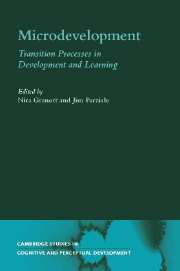Book contents
- Frontmatter
- Contents
- List of figures
- List of tables
- List of contributors
- Microdevelopment: A process-oriented perspective for studying development and learning
- Part I Variability
- Part II Transition mechanisms
- Part III Micro- and macrodevelopment
- Part IV Context
- 10 Notebooks as windows on learning: The case of a science-into-ESL program
- 11 Darwin's construction of the theory of evolution: Microdevelopment of explanations of variation and change in species
- 12 Developmental dynamics, intentional action, and fuzzy sets
- Author index
- Subject index
- References
12 - Developmental dynamics, intentional action, and fuzzy sets
Published online by Cambridge University Press: 22 September 2009
- Frontmatter
- Contents
- List of figures
- List of tables
- List of contributors
- Microdevelopment: A process-oriented perspective for studying development and learning
- Part I Variability
- Part II Transition mechanisms
- Part III Micro- and macrodevelopment
- Part IV Context
- 10 Notebooks as windows on learning: The case of a science-into-ESL program
- 11 Darwin's construction of the theory of evolution: Microdevelopment of explanations of variation and change in species
- 12 Developmental dynamics, intentional action, and fuzzy sets
- Author index
- Subject index
- References
Summary
One of the most striking findings of microdevelopmental studies is the existence of a considerable degree of variability in a person's performance levels (Crowley, Shrager, & Siegler, 1997; Fletcher, Huffman, Bray, & Grupe, 1998; Kuhn, Garcia-Mila, Zohar, & Andersen, 1995; Kuhn, 1995; Nakatani, 1995; Siegler, 1995). In addition, variability itself seems to vary between persons and conditions too (Alibali, 1999; Goldin-Meadow, Alibali, & Church, 1993). Still another finding is that individuals differ among one another in the way they reach a developmental outcome or in the way they show the psychological property under scrutiny (for instance, the use of a particular cognitive strategy) (Siegler, 1994, 1995, 1997; Siegler & Shipley, 1995; Siegler & Chen, 1998; Lautrey, 1993; Lautrey & Caroff, 1996).
The standard view on variability – which I shall confine to fluctuations in a person's level across time – is that it is more closely related to the notions of error and deception than to the idea of truth. The psychologist is like Narcissus, who looks at his face mirrored by the water of a pond that is touched by a gale of wind. The wrinkles he sees are those of the water, not of his face. If we study a property such as a person's level of skill, knowledge, intelligence – all alleged internal properties – we look at that property through some medium, for instance a test, an observation of spontaneous behavior, and so forth.
- Type
- Chapter
- Information
- MicrodevelopmentTransition Processes in Development and Learning, pp. 319 - 343Publisher: Cambridge University PressPrint publication year: 2002
References
- 10
- Cited by



